Making the Trench and Connecting the Collector
My helper Chris Haggard and I dug the trench on the hottest say of the year. Because this is a drainback system, I did not have to go below frost line. The trench is only about 2 feet deep.
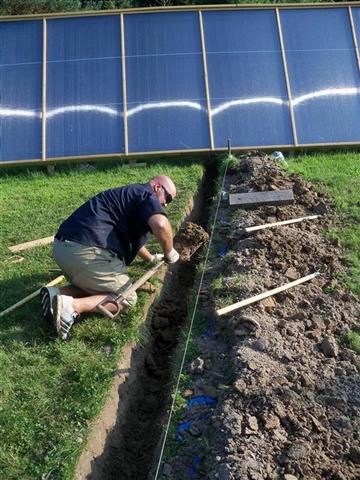
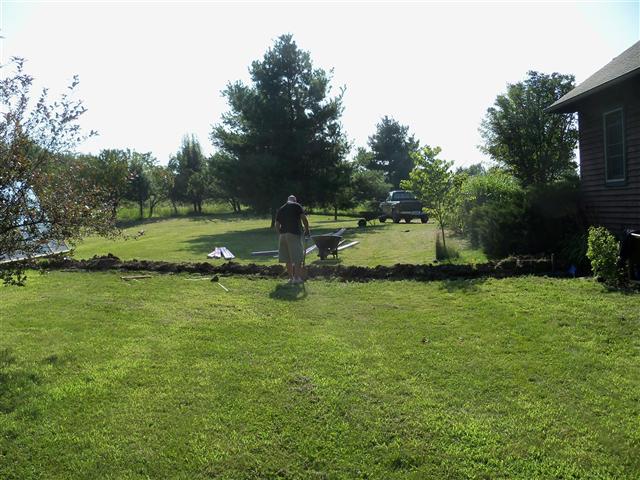
Here's the trench, with a layer of gravel at the bottom, where it reaches the collector.The pipes are ready for connection:
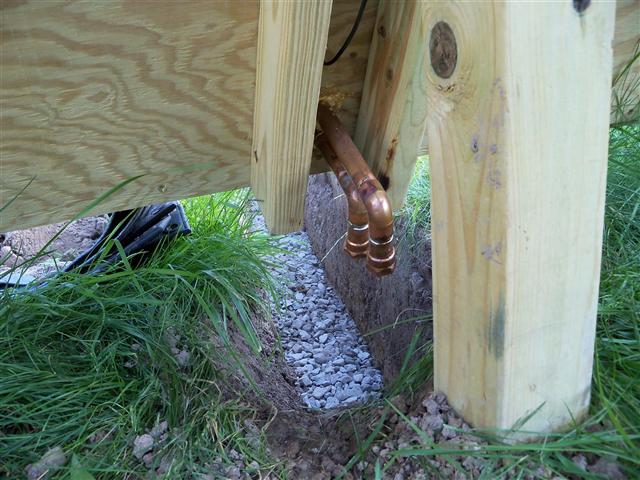
Once again I slightly adapted one of Gary Reysa's ideas and constructed a block of insulation for the pipes in the trench. I took a 6" wide piece of 2" polystyrene and routed a groove in it to accept a 1/2" piece of foam — to separate the warmer return pipe from the supply pipe (this was probably overkill, but I am The Maniac). Two outer strips are glued to this bottom block with Great Stuff foam. Eventually a top piece of 2" foam will be added to make a sandwich of insulation.
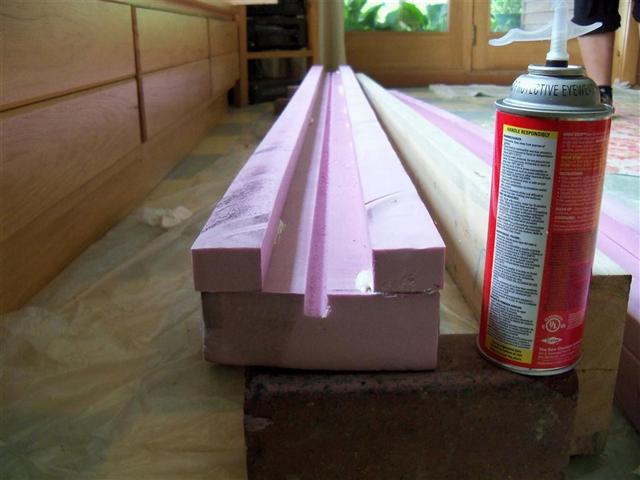
I weighed down the foam with a 2x6 and bricks to keep the foam from expanding too much as it cured:
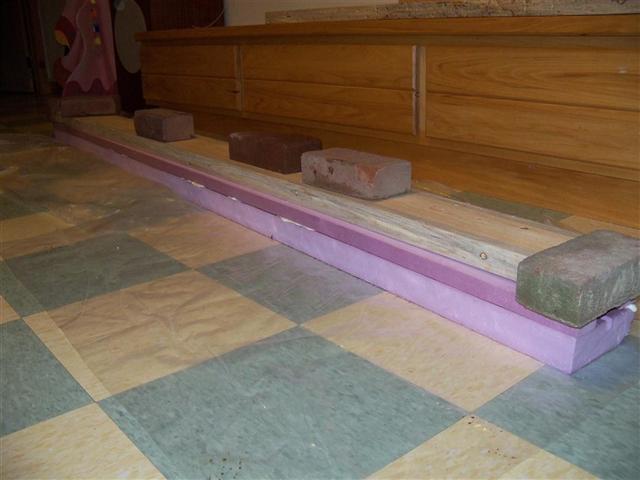
I had planned to use 3/4" pex-al-pex for the pipe runs to the house, but got a lucky break. I ordered 100 ft of pex, but the roll came a few feet short and was just less than I needed. So I switched to CPVC, which was much easier to deal with as it straight. Here the glued-up CPVC is laid in the foam channel:
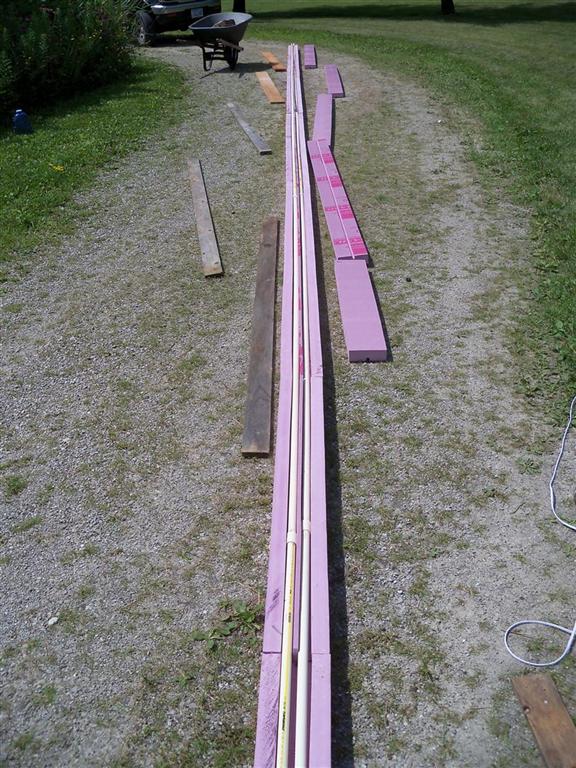
Great Stuff foam glues the top piece on, with bricks on top for weight:
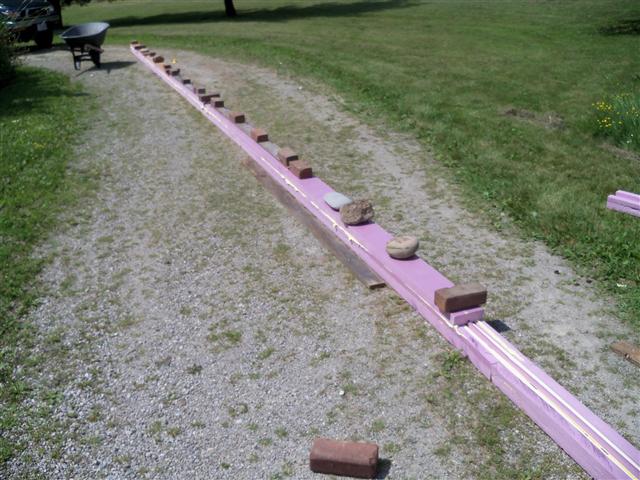
You can see the 1/2" strip of foam separating the two pipes, and the wires that will connect to the temperature sensor in the collector:
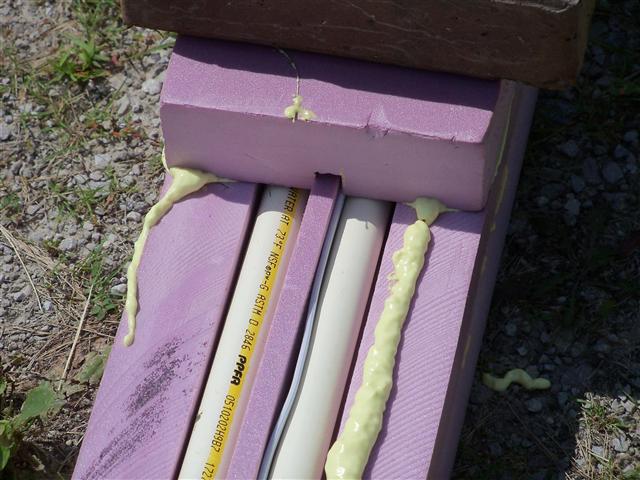
Here is the end that will connect to the collector. I transition from CPVC to short pieces of pex-al-pex (for bendability):
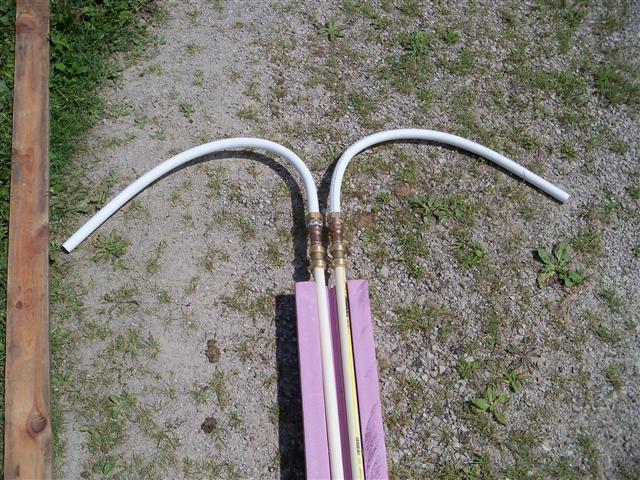
I used Sharkbite connectors from the CPVC to copper, then a copper fitting that connects to the compression fitting for the pex-al-pex. And I continued the foam insulating channel (modified) as far as I could:
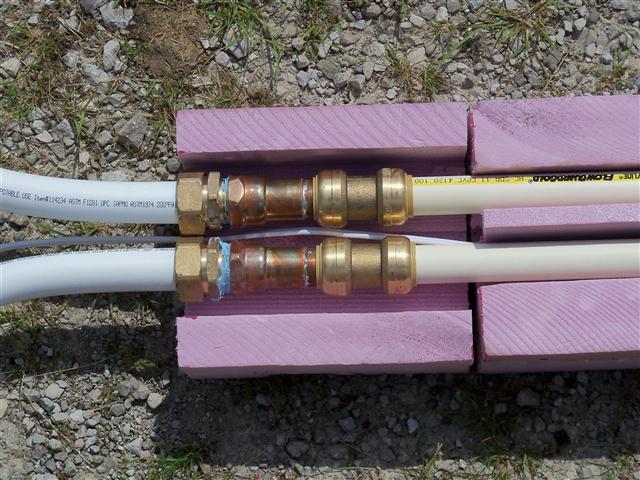
The next photo is the first trench attempt, with the insulated pipes installed. Turns out this was too shallow, as I had not properly accounted for the rather deep swale (an intentional dip in the grade to keep rain runoff away from the house) that exists between the collector and the house. So I had to excavate the insulated pipe, drill another hole through the foundation a foot or s deeper, re-dig the trench, and lay it again. A lot of work, but much better the second time.
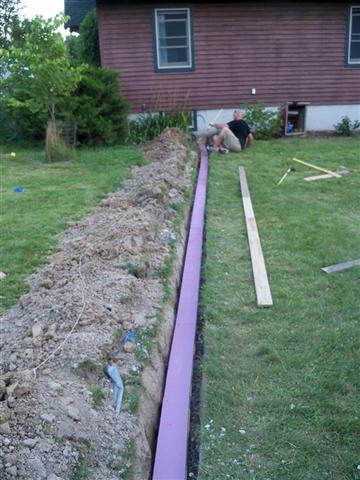
The pex-al-pex at the collector:
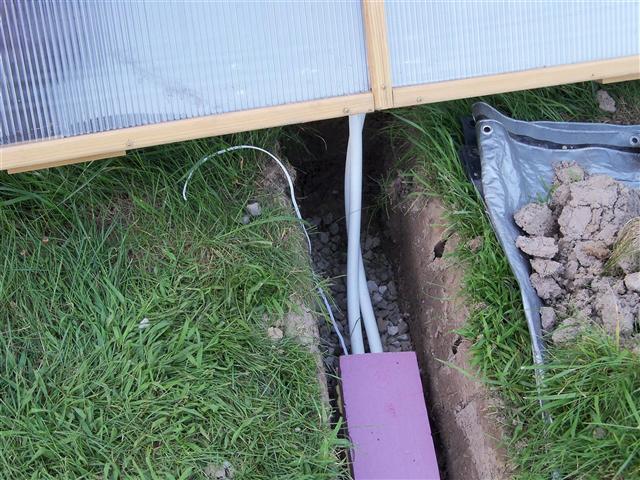
The supply and return lines insulated with foam covers at the back of the collector (the copper still needs insulating):
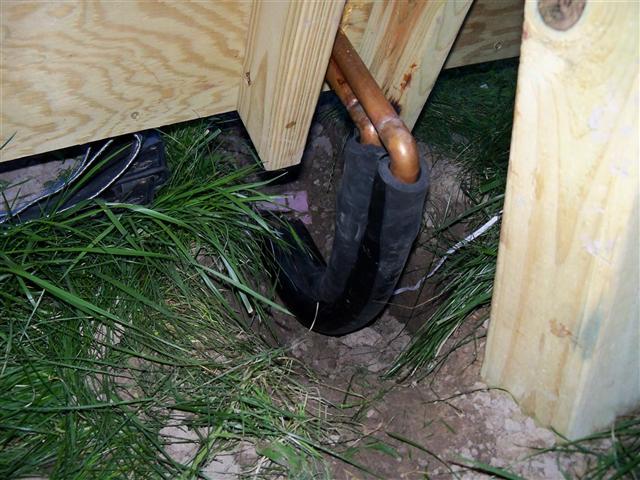
Flood!
On the first trench attempt, I did not seal the basement penetration right away, because (1) it was not supposed to rain, and (2) I had slightly sloped the hole toward the outside, so I thought any moisture might not come in.
Natutrally, we got a big rain, and because of the swale (which catches rain runoff from a huge area of the lawn) and the fact that it crosses the loose fill of the trench — a tremendous amount of water apparently went into the trench. The shop was soaked. My first clue of that was a sweet smell of wet sawdust when I came into the basement, as I keep years worth of sawdust inder the radial saw.
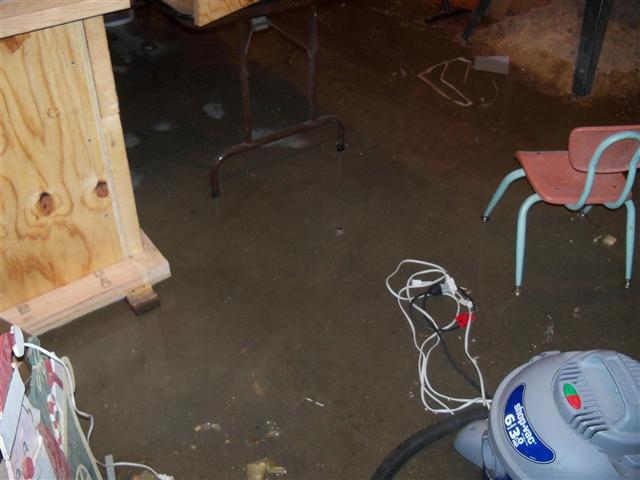
The strange thing is that a funky little bench below the hole — which was separated by almost a foot from the wall — also got completely soaked. That means the water
gushed through the opening with enough force to cross a foot of space. This was one of many "educational" experiences during the project about the ways of water...
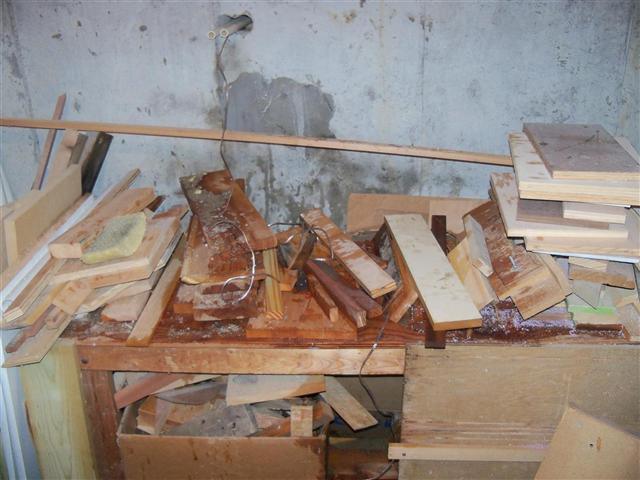
So I closed up the hole with Great Stuff (a bit much):
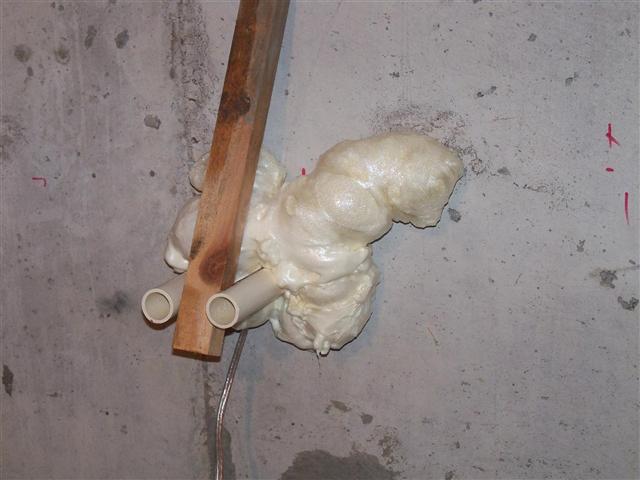
Trimmed back — and it has held against major storms so far.
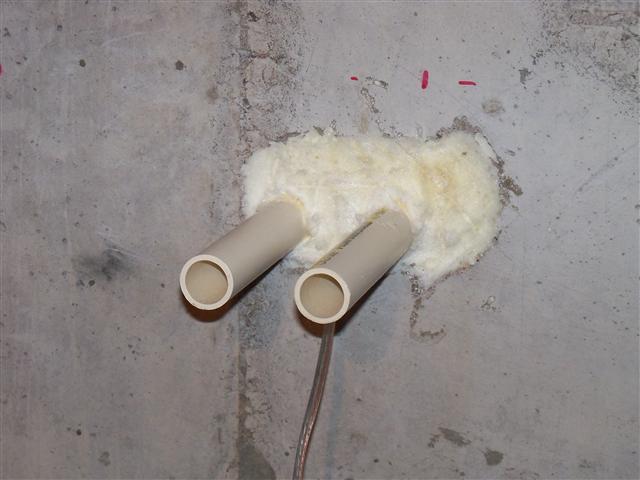 Next page (Heating the House) >>
Next page (Heating the House) >>

 Here's the trench, with a layer of gravel at the bottom, where it reaches the collector.The pipes are ready for connection:
Here's the trench, with a layer of gravel at the bottom, where it reaches the collector.The pipes are ready for connection:
 Once again I slightly adapted one of Gary Reysa's ideas and constructed a block of insulation for the pipes in the trench. I took a 6" wide piece of 2" polystyrene and routed a groove in it to accept a 1/2" piece of foam — to separate the warmer return pipe from the supply pipe (this was probably overkill, but I am The Maniac). Two outer strips are glued to this bottom block with Great Stuff foam. Eventually a top piece of 2" foam will be added to make a sandwich of insulation.
Once again I slightly adapted one of Gary Reysa's ideas and constructed a block of insulation for the pipes in the trench. I took a 6" wide piece of 2" polystyrene and routed a groove in it to accept a 1/2" piece of foam — to separate the warmer return pipe from the supply pipe (this was probably overkill, but I am The Maniac). Two outer strips are glued to this bottom block with Great Stuff foam. Eventually a top piece of 2" foam will be added to make a sandwich of insulation.
 I weighed down the foam with a 2x6 and bricks to keep the foam from expanding too much as it cured:
I weighed down the foam with a 2x6 and bricks to keep the foam from expanding too much as it cured:
 I had planned to use 3/4" pex-al-pex for the pipe runs to the house, but got a lucky break. I ordered 100 ft of pex, but the roll came a few feet short and was just less than I needed. So I switched to CPVC, which was much easier to deal with as it straight. Here the glued-up CPVC is laid in the foam channel:
I had planned to use 3/4" pex-al-pex for the pipe runs to the house, but got a lucky break. I ordered 100 ft of pex, but the roll came a few feet short and was just less than I needed. So I switched to CPVC, which was much easier to deal with as it straight. Here the glued-up CPVC is laid in the foam channel:
 Great Stuff foam glues the top piece on, with bricks on top for weight:
Great Stuff foam glues the top piece on, with bricks on top for weight:
 You can see the 1/2" strip of foam separating the two pipes, and the wires that will connect to the temperature sensor in the collector:
You can see the 1/2" strip of foam separating the two pipes, and the wires that will connect to the temperature sensor in the collector:
 Here is the end that will connect to the collector. I transition from CPVC to short pieces of pex-al-pex (for bendability):
Here is the end that will connect to the collector. I transition from CPVC to short pieces of pex-al-pex (for bendability):
 I used Sharkbite connectors from the CPVC to copper, then a copper fitting that connects to the compression fitting for the pex-al-pex. And I continued the foam insulating channel (modified) as far as I could:
I used Sharkbite connectors from the CPVC to copper, then a copper fitting that connects to the compression fitting for the pex-al-pex. And I continued the foam insulating channel (modified) as far as I could:
 The next photo is the first trench attempt, with the insulated pipes installed. Turns out this was too shallow, as I had not properly accounted for the rather deep swale (an intentional dip in the grade to keep rain runoff away from the house) that exists between the collector and the house. So I had to excavate the insulated pipe, drill another hole through the foundation a foot or s deeper, re-dig the trench, and lay it again. A lot of work, but much better the second time.
The next photo is the first trench attempt, with the insulated pipes installed. Turns out this was too shallow, as I had not properly accounted for the rather deep swale (an intentional dip in the grade to keep rain runoff away from the house) that exists between the collector and the house. So I had to excavate the insulated pipe, drill another hole through the foundation a foot or s deeper, re-dig the trench, and lay it again. A lot of work, but much better the second time.
 The pex-al-pex at the collector:
The pex-al-pex at the collector:
 The supply and return lines insulated with foam covers at the back of the collector (the copper still needs insulating):
The supply and return lines insulated with foam covers at the back of the collector (the copper still needs insulating):

 The strange thing is that a funky little bench below the hole — which was separated by almost a foot from the wall — also got completely soaked. That means the water gushed through the opening with enough force to cross a foot of space. This was one of many "educational" experiences during the project about the ways of water...
The strange thing is that a funky little bench below the hole — which was separated by almost a foot from the wall — also got completely soaked. That means the water gushed through the opening with enough force to cross a foot of space. This was one of many "educational" experiences during the project about the ways of water...
 So I closed up the hole with Great Stuff (a bit much):
So I closed up the hole with Great Stuff (a bit much):
 Trimmed back — and it has held against major storms so far.
Trimmed back — and it has held against major storms so far.
 Next page (Heating the House) >>
Next page (Heating the House) >>